Healthcare and Its Impact on Society
VerifiedAdded on 2020/03/16
|11
|2248
|249
AI Summary
This assignment delves into the multifaceted aspects of healthcare and its profound influence on society. It examines various diseases and their impact, explores different treatment modalities, and analyzes the interplay between healthcare systems and societal well-being. The provided resources encompass research articles, clinical studies, and expert opinions, offering a comprehensive understanding of contemporary healthcare challenges and advancements.
Contribute Materials
Your contribution can guide someone’s learning journey. Share your
documents today.
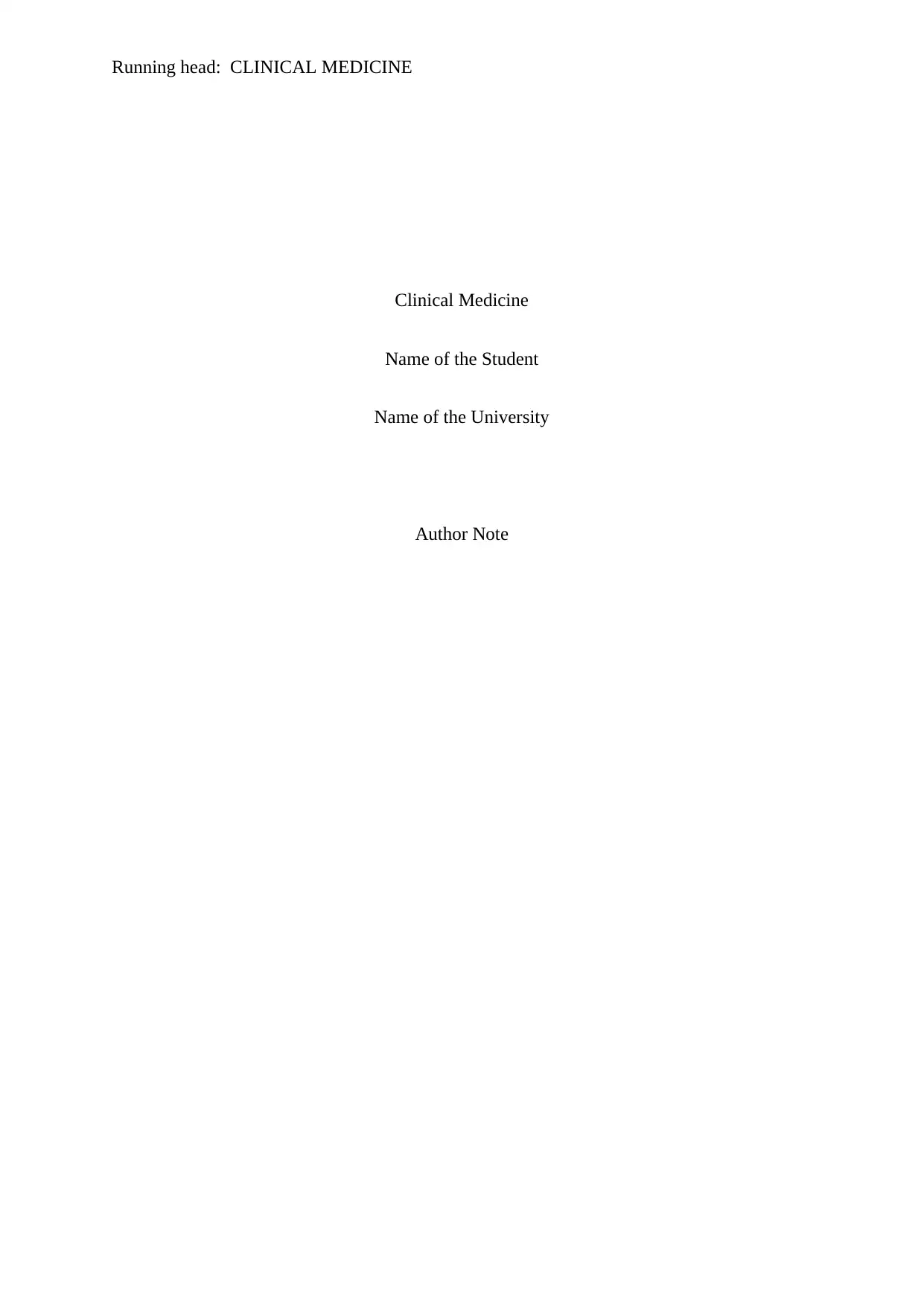
Running head: CLINICAL MEDICINE
Clinical Medicine
Name of the Student
Name of the University
Author Note
Clinical Medicine
Name of the Student
Name of the University
Author Note
Secure Best Marks with AI Grader
Need help grading? Try our AI Grader for instant feedback on your assignments.
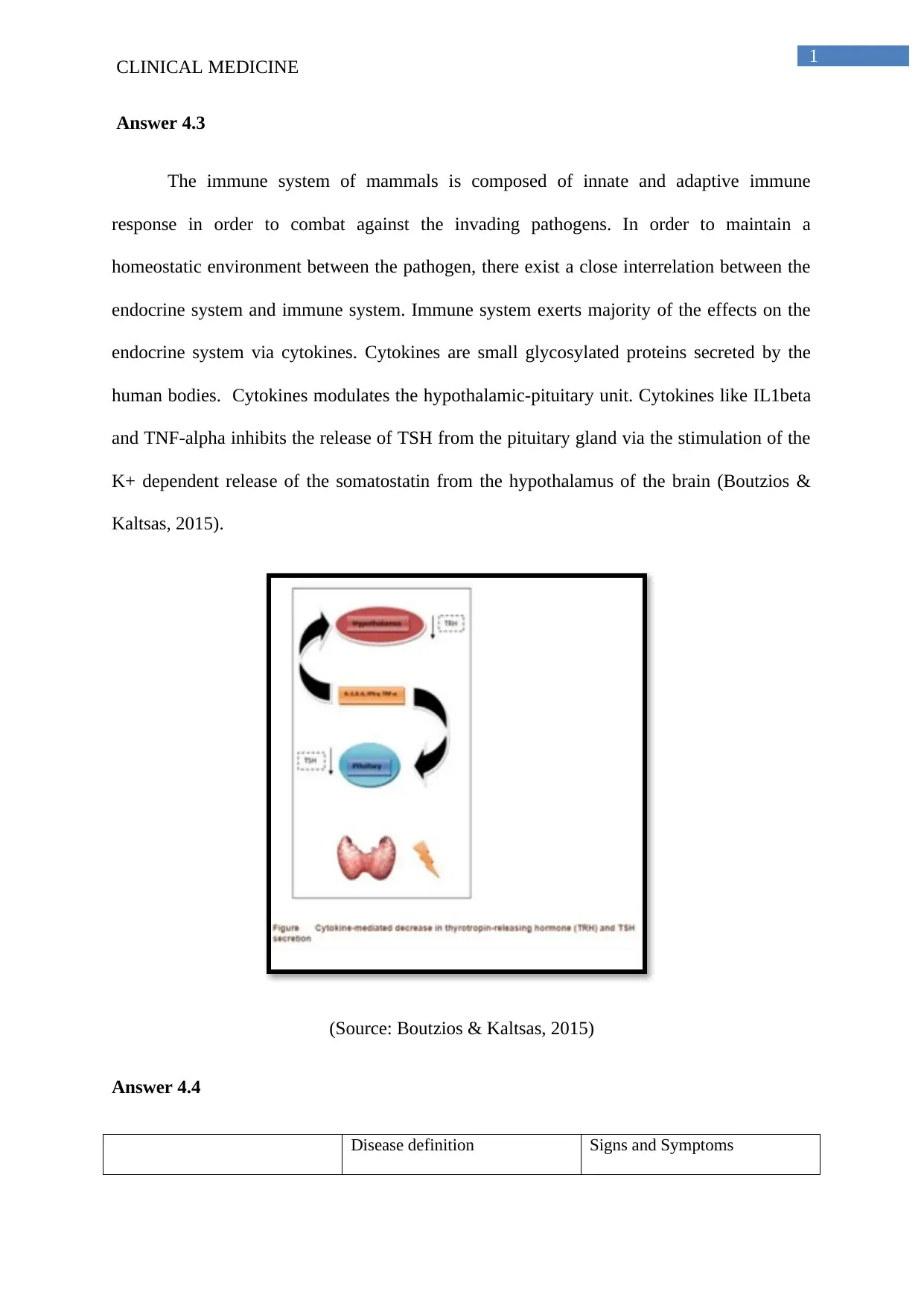
1
CLINICAL MEDICINE
Answer 4.3
The immune system of mammals is composed of innate and adaptive immune
response in order to combat against the invading pathogens. In order to maintain a
homeostatic environment between the pathogen, there exist a close interrelation between the
endocrine system and immune system. Immune system exerts majority of the effects on the
endocrine system via cytokines. Cytokines are small glycosylated proteins secreted by the
human bodies. Cytokines modulates the hypothalamic-pituitary unit. Cytokines like IL1beta
and TNF-alpha inhibits the release of TSH from the pituitary gland via the stimulation of the
K+ dependent release of the somatostatin from the hypothalamus of the brain (Boutzios &
Kaltsas, 2015).
(Source: Boutzios & Kaltsas, 2015)
Answer 4.4
Disease definition Signs and Symptoms
CLINICAL MEDICINE
Answer 4.3
The immune system of mammals is composed of innate and adaptive immune
response in order to combat against the invading pathogens. In order to maintain a
homeostatic environment between the pathogen, there exist a close interrelation between the
endocrine system and immune system. Immune system exerts majority of the effects on the
endocrine system via cytokines. Cytokines are small glycosylated proteins secreted by the
human bodies. Cytokines modulates the hypothalamic-pituitary unit. Cytokines like IL1beta
and TNF-alpha inhibits the release of TSH from the pituitary gland via the stimulation of the
K+ dependent release of the somatostatin from the hypothalamus of the brain (Boutzios &
Kaltsas, 2015).
(Source: Boutzios & Kaltsas, 2015)
Answer 4.4
Disease definition Signs and Symptoms
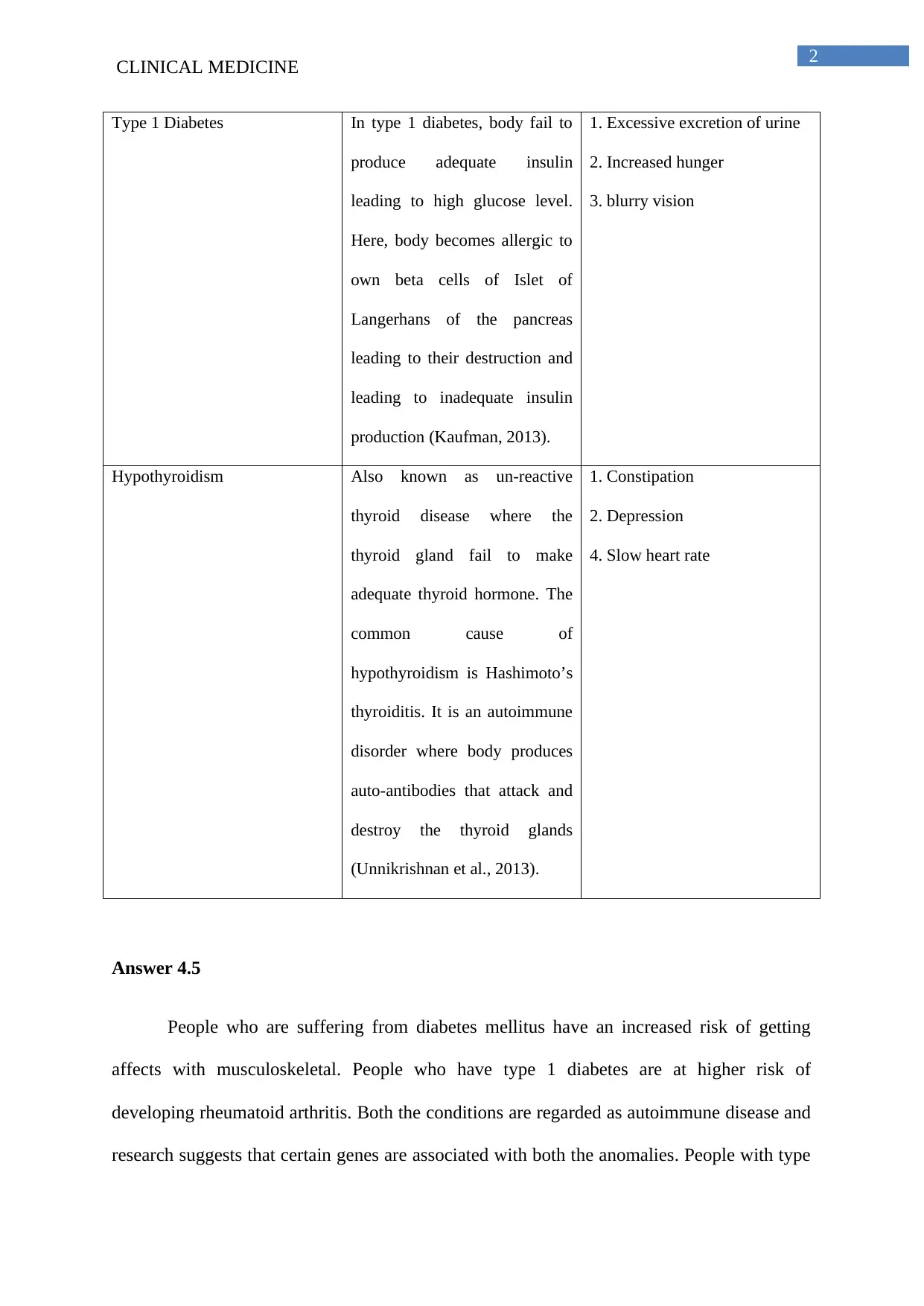
2
CLINICAL MEDICINE
Type 1 Diabetes In type 1 diabetes, body fail to
produce adequate insulin
leading to high glucose level.
Here, body becomes allergic to
own beta cells of Islet of
Langerhans of the pancreas
leading to their destruction and
leading to inadequate insulin
production (Kaufman, 2013).
1. Excessive excretion of urine
2. Increased hunger
3. blurry vision
Hypothyroidism Also known as un-reactive
thyroid disease where the
thyroid gland fail to make
adequate thyroid hormone. The
common cause of
hypothyroidism is Hashimoto’s
thyroiditis. It is an autoimmune
disorder where body produces
auto-antibodies that attack and
destroy the thyroid glands
(Unnikrishnan et al., 2013).
1. Constipation
2. Depression
4. Slow heart rate
Answer 4.5
People who are suffering from diabetes mellitus have an increased risk of getting
affects with musculoskeletal. People who have type 1 diabetes are at higher risk of
developing rheumatoid arthritis. Both the conditions are regarded as autoimmune disease and
research suggests that certain genes are associated with both the anomalies. People with type
CLINICAL MEDICINE
Type 1 Diabetes In type 1 diabetes, body fail to
produce adequate insulin
leading to high glucose level.
Here, body becomes allergic to
own beta cells of Islet of
Langerhans of the pancreas
leading to their destruction and
leading to inadequate insulin
production (Kaufman, 2013).
1. Excessive excretion of urine
2. Increased hunger
3. blurry vision
Hypothyroidism Also known as un-reactive
thyroid disease where the
thyroid gland fail to make
adequate thyroid hormone. The
common cause of
hypothyroidism is Hashimoto’s
thyroiditis. It is an autoimmune
disorder where body produces
auto-antibodies that attack and
destroy the thyroid glands
(Unnikrishnan et al., 2013).
1. Constipation
2. Depression
4. Slow heart rate
Answer 4.5
People who are suffering from diabetes mellitus have an increased risk of getting
affects with musculoskeletal. People who have type 1 diabetes are at higher risk of
developing rheumatoid arthritis. Both the conditions are regarded as autoimmune disease and
research suggests that certain genes are associated with both the anomalies. People with type
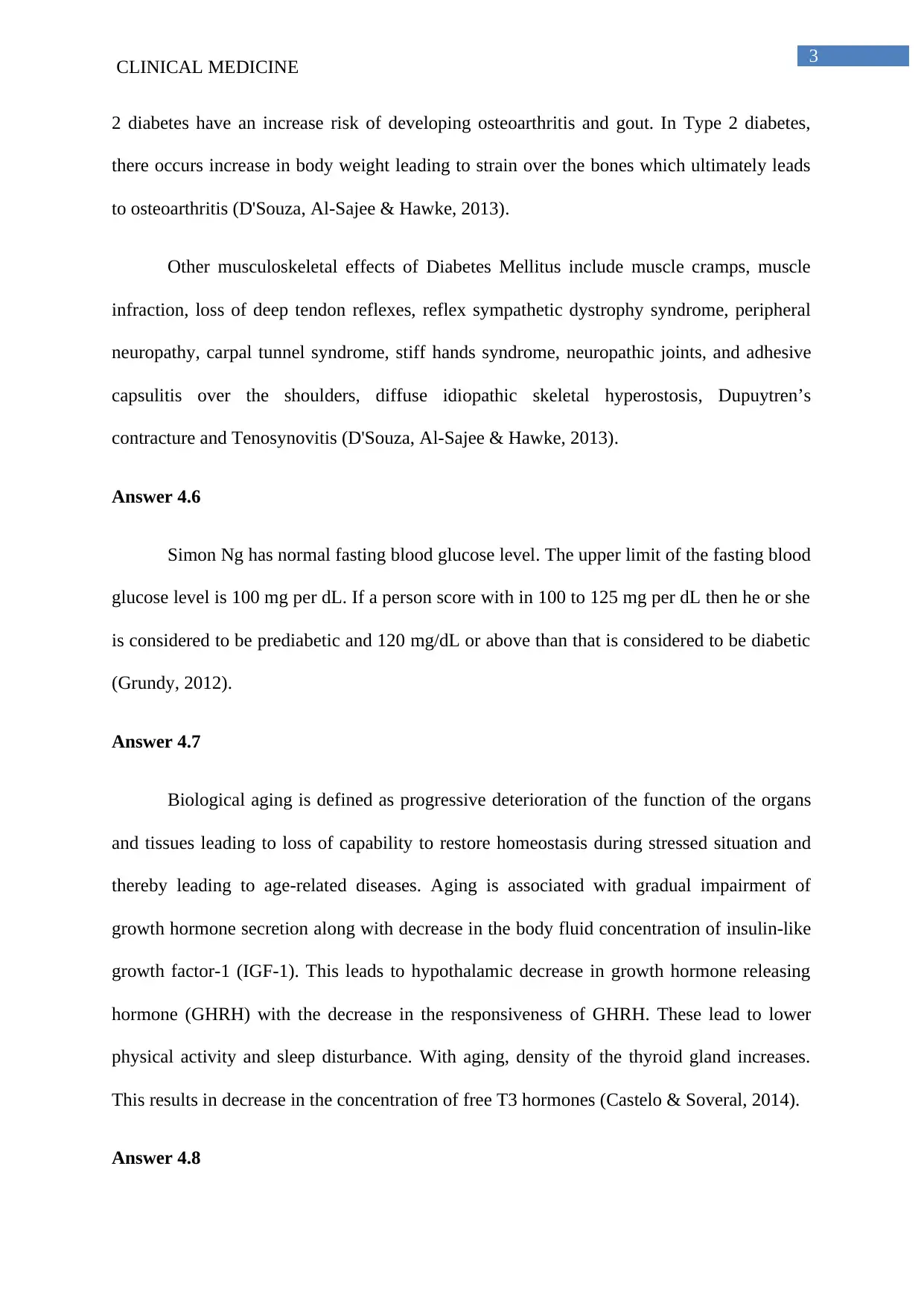
3
CLINICAL MEDICINE
2 diabetes have an increase risk of developing osteoarthritis and gout. In Type 2 diabetes,
there occurs increase in body weight leading to strain over the bones which ultimately leads
to osteoarthritis (D'Souza, Al-Sajee & Hawke, 2013).
Other musculoskeletal effects of Diabetes Mellitus include muscle cramps, muscle
infraction, loss of deep tendon reflexes, reflex sympathetic dystrophy syndrome, peripheral
neuropathy, carpal tunnel syndrome, stiff hands syndrome, neuropathic joints, and adhesive
capsulitis over the shoulders, diffuse idiopathic skeletal hyperostosis, Dupuytren’s
contracture and Tenosynovitis (D'Souza, Al-Sajee & Hawke, 2013).
Answer 4.6
Simon Ng has normal fasting blood glucose level. The upper limit of the fasting blood
glucose level is 100 mg per dL. If a person score with in 100 to 125 mg per dL then he or she
is considered to be prediabetic and 120 mg/dL or above than that is considered to be diabetic
(Grundy, 2012).
Answer 4.7
Biological aging is defined as progressive deterioration of the function of the organs
and tissues leading to loss of capability to restore homeostasis during stressed situation and
thereby leading to age-related diseases. Aging is associated with gradual impairment of
growth hormone secretion along with decrease in the body fluid concentration of insulin-like
growth factor-1 (IGF-1). This leads to hypothalamic decrease in growth hormone releasing
hormone (GHRH) with the decrease in the responsiveness of GHRH. These lead to lower
physical activity and sleep disturbance. With aging, density of the thyroid gland increases.
This results in decrease in the concentration of free T3 hormones (Castelo & Soveral, 2014).
Answer 4.8
CLINICAL MEDICINE
2 diabetes have an increase risk of developing osteoarthritis and gout. In Type 2 diabetes,
there occurs increase in body weight leading to strain over the bones which ultimately leads
to osteoarthritis (D'Souza, Al-Sajee & Hawke, 2013).
Other musculoskeletal effects of Diabetes Mellitus include muscle cramps, muscle
infraction, loss of deep tendon reflexes, reflex sympathetic dystrophy syndrome, peripheral
neuropathy, carpal tunnel syndrome, stiff hands syndrome, neuropathic joints, and adhesive
capsulitis over the shoulders, diffuse idiopathic skeletal hyperostosis, Dupuytren’s
contracture and Tenosynovitis (D'Souza, Al-Sajee & Hawke, 2013).
Answer 4.6
Simon Ng has normal fasting blood glucose level. The upper limit of the fasting blood
glucose level is 100 mg per dL. If a person score with in 100 to 125 mg per dL then he or she
is considered to be prediabetic and 120 mg/dL or above than that is considered to be diabetic
(Grundy, 2012).
Answer 4.7
Biological aging is defined as progressive deterioration of the function of the organs
and tissues leading to loss of capability to restore homeostasis during stressed situation and
thereby leading to age-related diseases. Aging is associated with gradual impairment of
growth hormone secretion along with decrease in the body fluid concentration of insulin-like
growth factor-1 (IGF-1). This leads to hypothalamic decrease in growth hormone releasing
hormone (GHRH) with the decrease in the responsiveness of GHRH. These lead to lower
physical activity and sleep disturbance. With aging, density of the thyroid gland increases.
This results in decrease in the concentration of free T3 hormones (Castelo & Soveral, 2014).
Answer 4.8
Secure Best Marks with AI Grader
Need help grading? Try our AI Grader for instant feedback on your assignments.
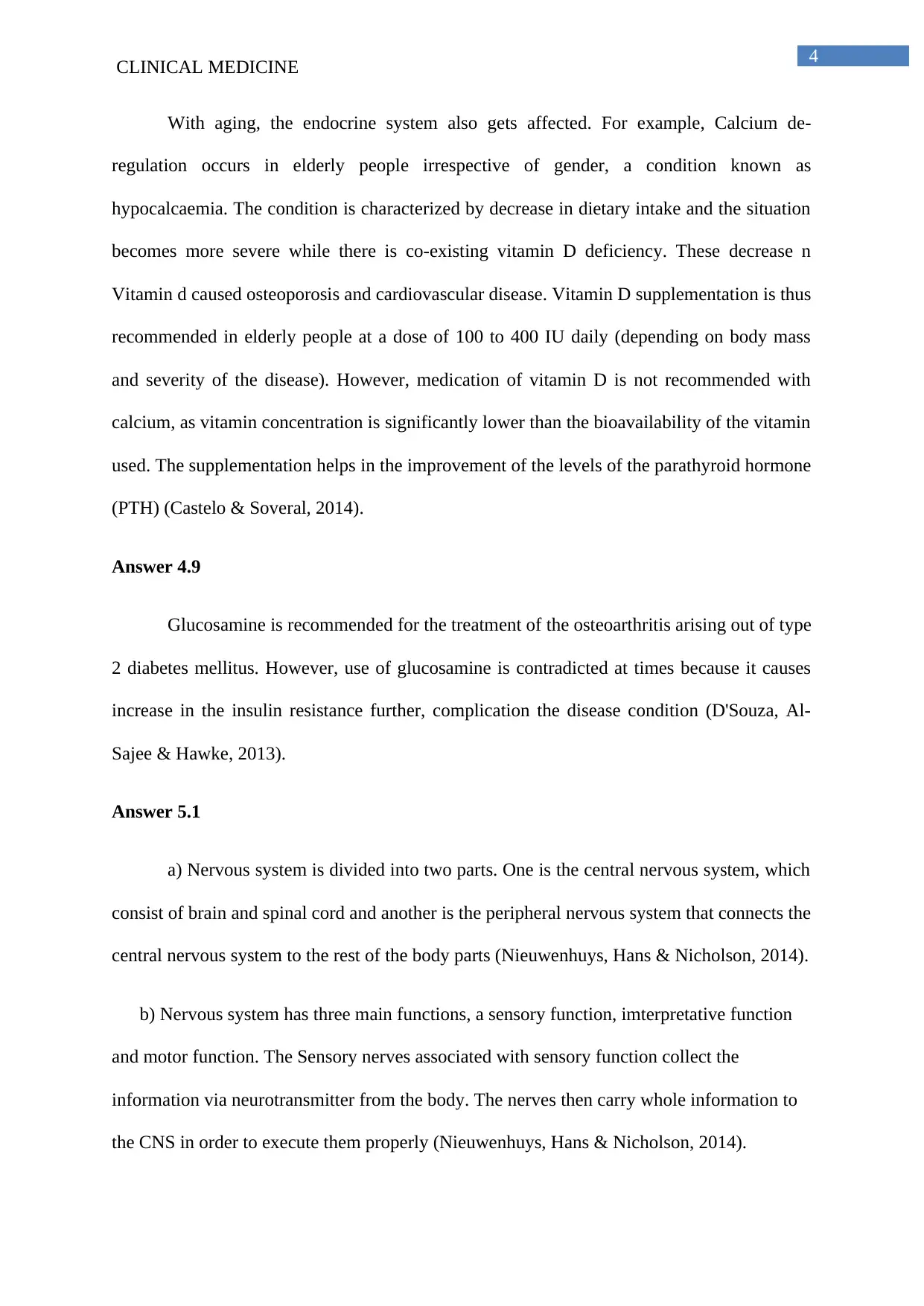
4
CLINICAL MEDICINE
With aging, the endocrine system also gets affected. For example, Calcium de-
regulation occurs in elderly people irrespective of gender, a condition known as
hypocalcaemia. The condition is characterized by decrease in dietary intake and the situation
becomes more severe while there is co-existing vitamin D deficiency. These decrease n
Vitamin d caused osteoporosis and cardiovascular disease. Vitamin D supplementation is thus
recommended in elderly people at a dose of 100 to 400 IU daily (depending on body mass
and severity of the disease). However, medication of vitamin D is not recommended with
calcium, as vitamin concentration is significantly lower than the bioavailability of the vitamin
used. The supplementation helps in the improvement of the levels of the parathyroid hormone
(PTH) (Castelo & Soveral, 2014).
Answer 4.9
Glucosamine is recommended for the treatment of the osteoarthritis arising out of type
2 diabetes mellitus. However, use of glucosamine is contradicted at times because it causes
increase in the insulin resistance further, complication the disease condition (D'Souza, Al-
Sajee & Hawke, 2013).
Answer 5.1
a) Nervous system is divided into two parts. One is the central nervous system, which
consist of brain and spinal cord and another is the peripheral nervous system that connects the
central nervous system to the rest of the body parts (Nieuwenhuys, Hans & Nicholson, 2014).
b) Nervous system has three main functions, a sensory function, imterpretative function
and motor function. The Sensory nerves associated with sensory function collect the
information via neurotransmitter from the body. The nerves then carry whole information to
the CNS in order to execute them properly (Nieuwenhuys, Hans & Nicholson, 2014).
CLINICAL MEDICINE
With aging, the endocrine system also gets affected. For example, Calcium de-
regulation occurs in elderly people irrespective of gender, a condition known as
hypocalcaemia. The condition is characterized by decrease in dietary intake and the situation
becomes more severe while there is co-existing vitamin D deficiency. These decrease n
Vitamin d caused osteoporosis and cardiovascular disease. Vitamin D supplementation is thus
recommended in elderly people at a dose of 100 to 400 IU daily (depending on body mass
and severity of the disease). However, medication of vitamin D is not recommended with
calcium, as vitamin concentration is significantly lower than the bioavailability of the vitamin
used. The supplementation helps in the improvement of the levels of the parathyroid hormone
(PTH) (Castelo & Soveral, 2014).
Answer 4.9
Glucosamine is recommended for the treatment of the osteoarthritis arising out of type
2 diabetes mellitus. However, use of glucosamine is contradicted at times because it causes
increase in the insulin resistance further, complication the disease condition (D'Souza, Al-
Sajee & Hawke, 2013).
Answer 5.1
a) Nervous system is divided into two parts. One is the central nervous system, which
consist of brain and spinal cord and another is the peripheral nervous system that connects the
central nervous system to the rest of the body parts (Nieuwenhuys, Hans & Nicholson, 2014).
b) Nervous system has three main functions, a sensory function, imterpretative function
and motor function. The Sensory nerves associated with sensory function collect the
information via neurotransmitter from the body. The nerves then carry whole information to
the CNS in order to execute them properly (Nieuwenhuys, Hans & Nicholson, 2014).
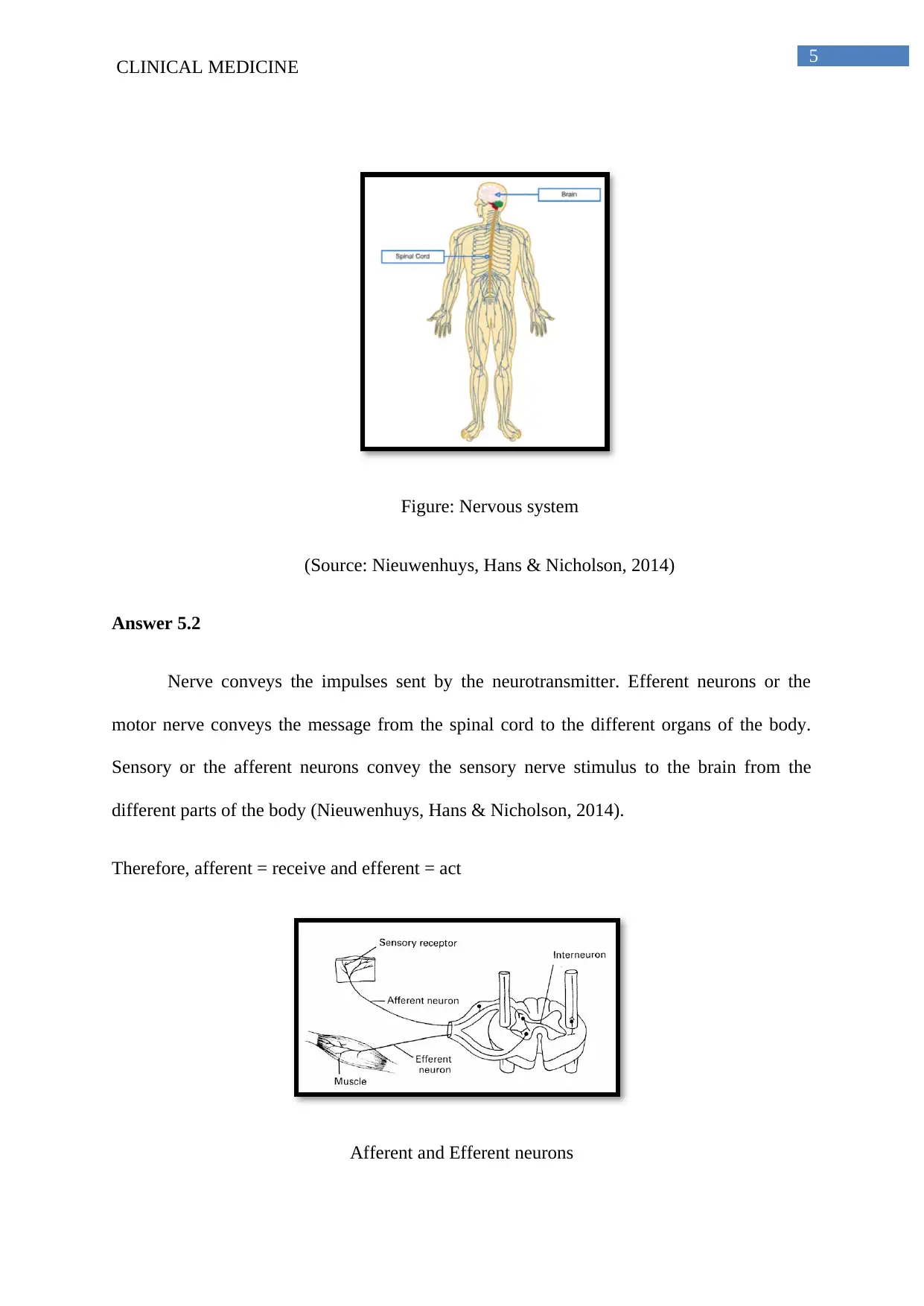
5
CLINICAL MEDICINE
Figure: Nervous system
(Source: Nieuwenhuys, Hans & Nicholson, 2014)
Answer 5.2
Nerve conveys the impulses sent by the neurotransmitter. Efferent neurons or the
motor nerve conveys the message from the spinal cord to the different organs of the body.
Sensory or the afferent neurons convey the sensory nerve stimulus to the brain from the
different parts of the body (Nieuwenhuys, Hans & Nicholson, 2014).
Therefore, afferent = receive and efferent = act
Afferent and Efferent neurons
CLINICAL MEDICINE
Figure: Nervous system
(Source: Nieuwenhuys, Hans & Nicholson, 2014)
Answer 5.2
Nerve conveys the impulses sent by the neurotransmitter. Efferent neurons or the
motor nerve conveys the message from the spinal cord to the different organs of the body.
Sensory or the afferent neurons convey the sensory nerve stimulus to the brain from the
different parts of the body (Nieuwenhuys, Hans & Nicholson, 2014).
Therefore, afferent = receive and efferent = act
Afferent and Efferent neurons
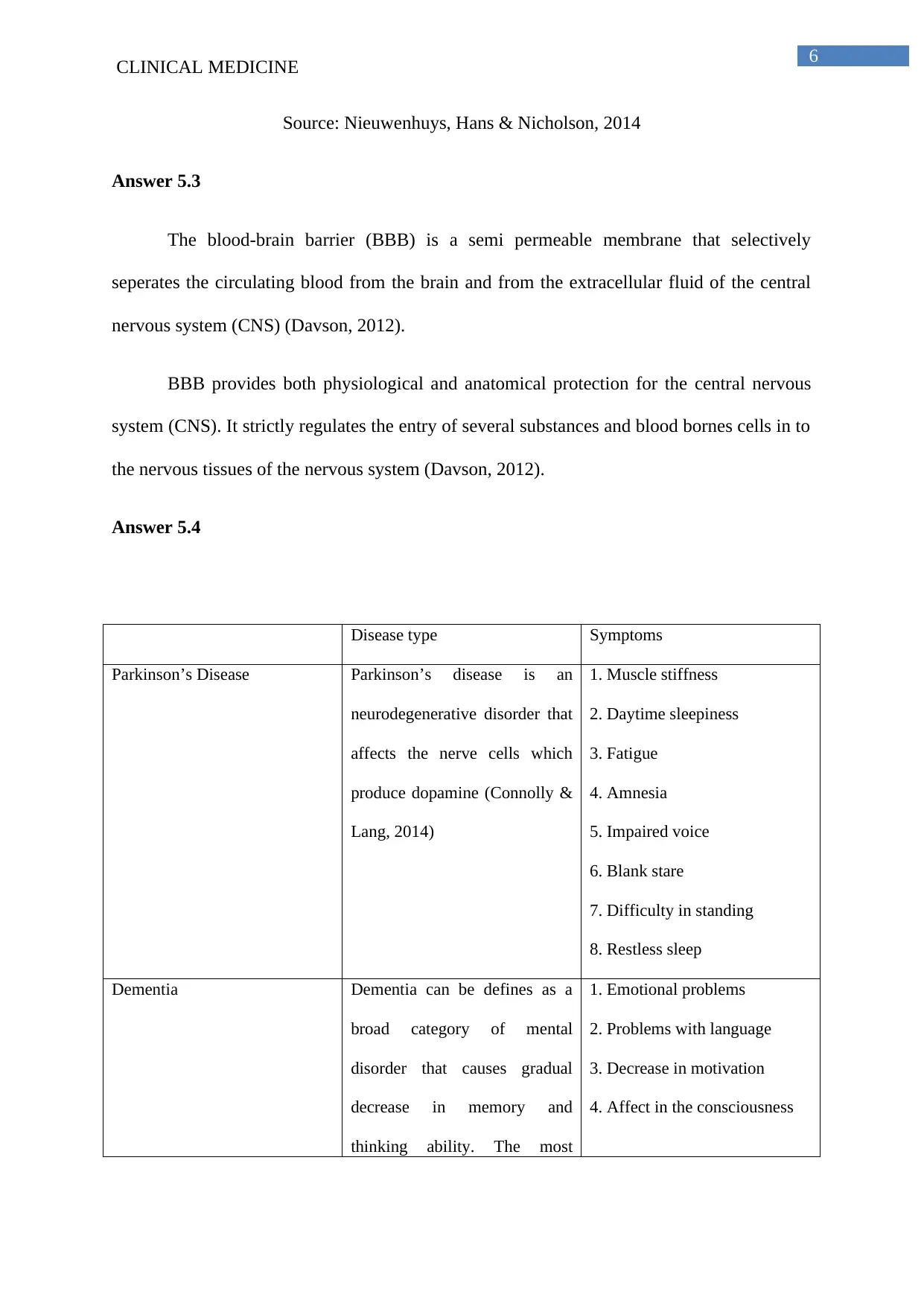
6
CLINICAL MEDICINE
Source: Nieuwenhuys, Hans & Nicholson, 2014
Answer 5.3
The blood-brain barrier (BBB) is a semi permeable membrane that selectively
seperates the circulating blood from the brain and from the extracellular fluid of the central
nervous system (CNS) (Davson, 2012).
BBB provides both physiological and anatomical protection for the central nervous
system (CNS). It strictly regulates the entry of several substances and blood bornes cells in to
the nervous tissues of the nervous system (Davson, 2012).
Answer 5.4
Disease type Symptoms
Parkinson’s Disease Parkinson’s disease is an
neurodegenerative disorder that
affects the nerve cells which
produce dopamine (Connolly &
Lang, 2014)
1. Muscle stiffness
2. Daytime sleepiness
3. Fatigue
4. Amnesia
5. Impaired voice
6. Blank stare
7. Difficulty in standing
8. Restless sleep
Dementia Dementia can be defines as a
broad category of mental
disorder that causes gradual
decrease in memory and
thinking ability. The most
1. Emotional problems
2. Problems with language
3. Decrease in motivation
4. Affect in the consciousness
CLINICAL MEDICINE
Source: Nieuwenhuys, Hans & Nicholson, 2014
Answer 5.3
The blood-brain barrier (BBB) is a semi permeable membrane that selectively
seperates the circulating blood from the brain and from the extracellular fluid of the central
nervous system (CNS) (Davson, 2012).
BBB provides both physiological and anatomical protection for the central nervous
system (CNS). It strictly regulates the entry of several substances and blood bornes cells in to
the nervous tissues of the nervous system (Davson, 2012).
Answer 5.4
Disease type Symptoms
Parkinson’s Disease Parkinson’s disease is an
neurodegenerative disorder that
affects the nerve cells which
produce dopamine (Connolly &
Lang, 2014)
1. Muscle stiffness
2. Daytime sleepiness
3. Fatigue
4. Amnesia
5. Impaired voice
6. Blank stare
7. Difficulty in standing
8. Restless sleep
Dementia Dementia can be defines as a
broad category of mental
disorder that causes gradual
decrease in memory and
thinking ability. The most
1. Emotional problems
2. Problems with language
3. Decrease in motivation
4. Affect in the consciousness
Paraphrase This Document
Need a fresh take? Get an instant paraphrase of this document with our AI Paraphraser
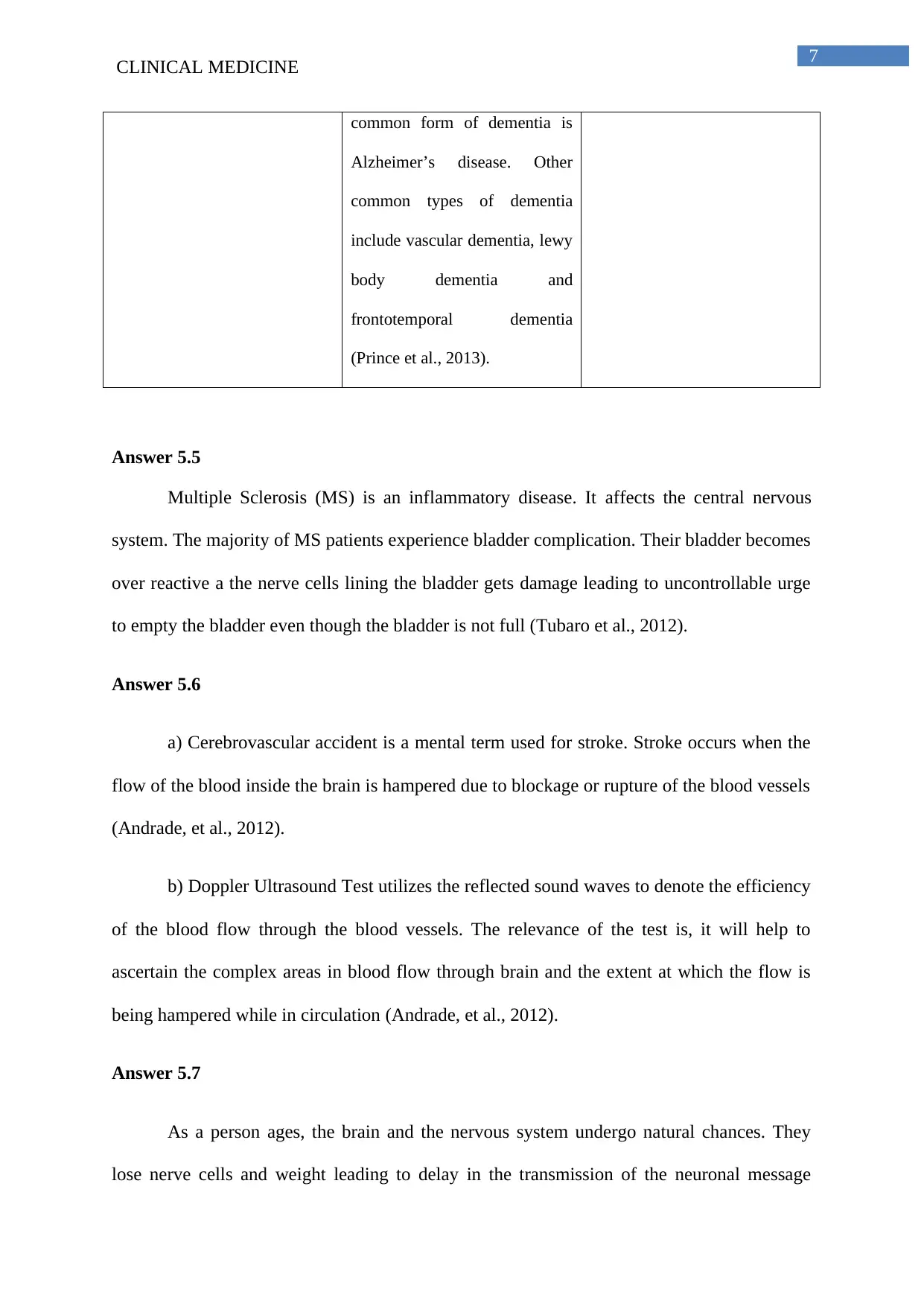
7
CLINICAL MEDICINE
common form of dementia is
Alzheimer’s disease. Other
common types of dementia
include vascular dementia, lewy
body dementia and
frontotemporal dementia
(Prince et al., 2013).
Answer 5.5
Multiple Sclerosis (MS) is an inflammatory disease. It affects the central nervous
system. The majority of MS patients experience bladder complication. Their bladder becomes
over reactive a the nerve cells lining the bladder gets damage leading to uncontrollable urge
to empty the bladder even though the bladder is not full (Tubaro et al., 2012).
Answer 5.6
a) Cerebrovascular accident is a mental term used for stroke. Stroke occurs when the
flow of the blood inside the brain is hampered due to blockage or rupture of the blood vessels
(Andrade, et al., 2012).
b) Doppler Ultrasound Test utilizes the reflected sound waves to denote the efficiency
of the blood flow through the blood vessels. The relevance of the test is, it will help to
ascertain the complex areas in blood flow through brain and the extent at which the flow is
being hampered while in circulation (Andrade, et al., 2012).
Answer 5.7
As a person ages, the brain and the nervous system undergo natural chances. They
lose nerve cells and weight leading to delay in the transmission of the neuronal message
CLINICAL MEDICINE
common form of dementia is
Alzheimer’s disease. Other
common types of dementia
include vascular dementia, lewy
body dementia and
frontotemporal dementia
(Prince et al., 2013).
Answer 5.5
Multiple Sclerosis (MS) is an inflammatory disease. It affects the central nervous
system. The majority of MS patients experience bladder complication. Their bladder becomes
over reactive a the nerve cells lining the bladder gets damage leading to uncontrollable urge
to empty the bladder even though the bladder is not full (Tubaro et al., 2012).
Answer 5.6
a) Cerebrovascular accident is a mental term used for stroke. Stroke occurs when the
flow of the blood inside the brain is hampered due to blockage or rupture of the blood vessels
(Andrade, et al., 2012).
b) Doppler Ultrasound Test utilizes the reflected sound waves to denote the efficiency
of the blood flow through the blood vessels. The relevance of the test is, it will help to
ascertain the complex areas in blood flow through brain and the extent at which the flow is
being hampered while in circulation (Andrade, et al., 2012).
Answer 5.7
As a person ages, the brain and the nervous system undergo natural chances. They
lose nerve cells and weight leading to delay in the transmission of the neuronal message
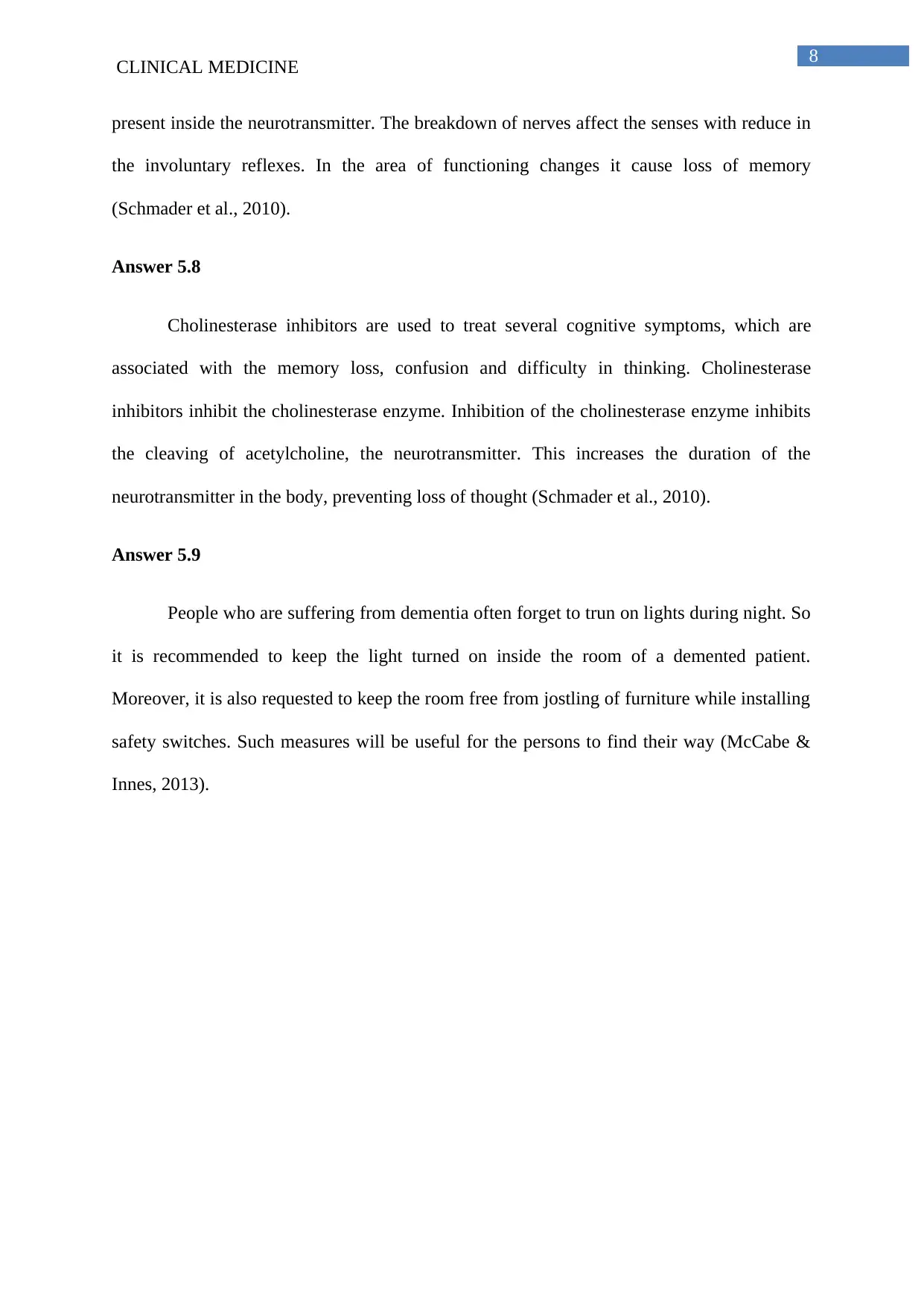
8
CLINICAL MEDICINE
present inside the neurotransmitter. The breakdown of nerves affect the senses with reduce in
the involuntary reflexes. In the area of functioning changes it cause loss of memory
(Schmader et al., 2010).
Answer 5.8
Cholinesterase inhibitors are used to treat several cognitive symptoms, which are
associated with the memory loss, confusion and difficulty in thinking. Cholinesterase
inhibitors inhibit the cholinesterase enzyme. Inhibition of the cholinesterase enzyme inhibits
the cleaving of acetylcholine, the neurotransmitter. This increases the duration of the
neurotransmitter in the body, preventing loss of thought (Schmader et al., 2010).
Answer 5.9
People who are suffering from dementia often forget to trun on lights during night. So
it is recommended to keep the light turned on inside the room of a demented patient.
Moreover, it is also requested to keep the room free from jostling of furniture while installing
safety switches. Such measures will be useful for the persons to find their way (McCabe &
Innes, 2013).
CLINICAL MEDICINE
present inside the neurotransmitter. The breakdown of nerves affect the senses with reduce in
the involuntary reflexes. In the area of functioning changes it cause loss of memory
(Schmader et al., 2010).
Answer 5.8
Cholinesterase inhibitors are used to treat several cognitive symptoms, which are
associated with the memory loss, confusion and difficulty in thinking. Cholinesterase
inhibitors inhibit the cholinesterase enzyme. Inhibition of the cholinesterase enzyme inhibits
the cleaving of acetylcholine, the neurotransmitter. This increases the duration of the
neurotransmitter in the body, preventing loss of thought (Schmader et al., 2010).
Answer 5.9
People who are suffering from dementia often forget to trun on lights during night. So
it is recommended to keep the light turned on inside the room of a demented patient.
Moreover, it is also requested to keep the room free from jostling of furniture while installing
safety switches. Such measures will be useful for the persons to find their way (McCabe &
Innes, 2013).
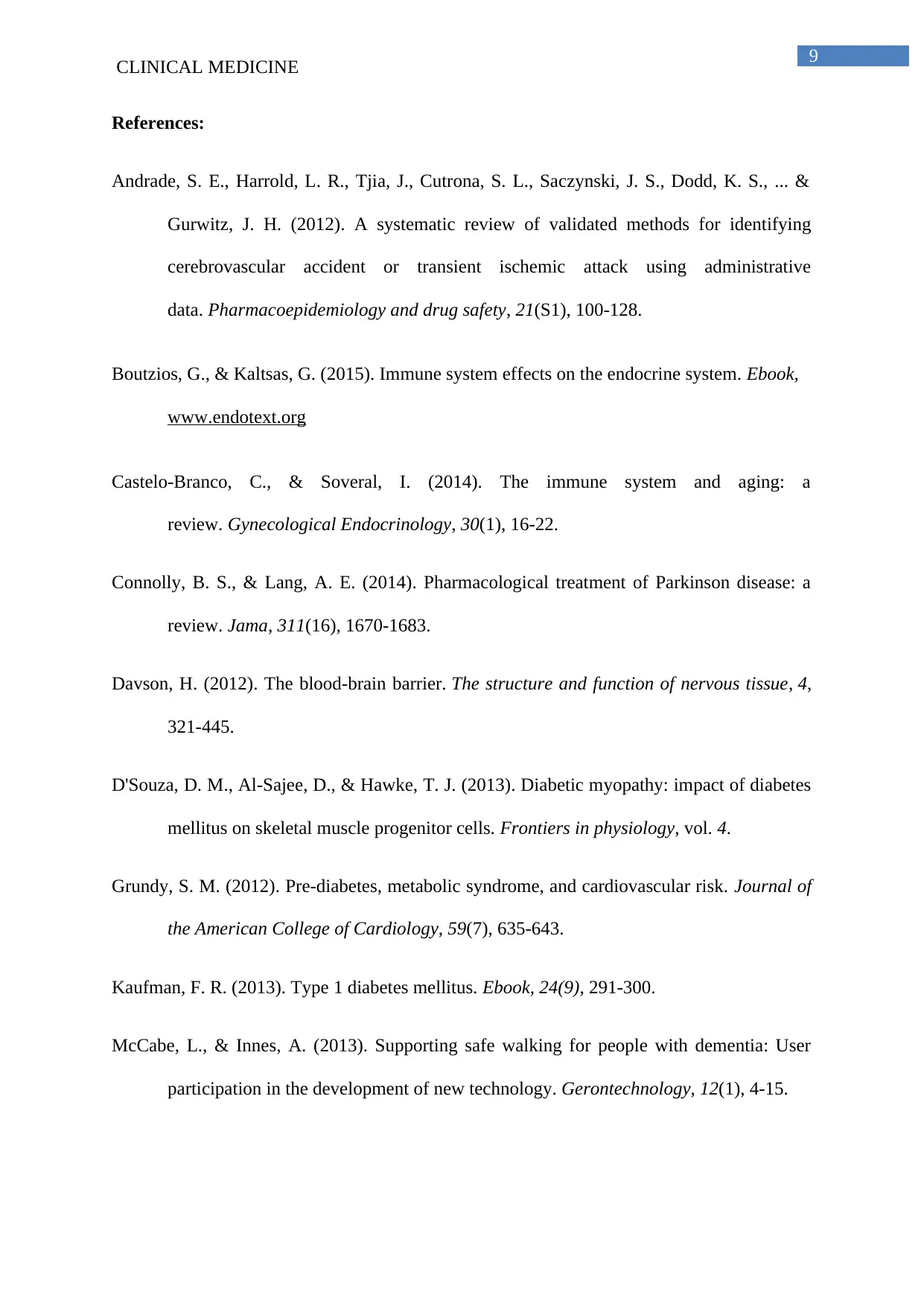
9
CLINICAL MEDICINE
References:
Andrade, S. E., Harrold, L. R., Tjia, J., Cutrona, S. L., Saczynski, J. S., Dodd, K. S., ... &
Gurwitz, J. H. (2012). A systematic review of validated methods for identifying
cerebrovascular accident or transient ischemic attack using administrative
data. Pharmacoepidemiology and drug safety, 21(S1), 100-128.
Boutzios, G., & Kaltsas, G. (2015). Immune system effects on the endocrine system. Ebook,
www.endotext.org
Castelo-Branco, C., & Soveral, I. (2014). The immune system and aging: a
review. Gynecological Endocrinology, 30(1), 16-22.
Connolly, B. S., & Lang, A. E. (2014). Pharmacological treatment of Parkinson disease: a
review. Jama, 311(16), 1670-1683.
Davson, H. (2012). The blood-brain barrier. The structure and function of nervous tissue, 4,
321-445.
D'Souza, D. M., Al-Sajee, D., & Hawke, T. J. (2013). Diabetic myopathy: impact of diabetes
mellitus on skeletal muscle progenitor cells. Frontiers in physiology, vol. 4.
Grundy, S. M. (2012). Pre-diabetes, metabolic syndrome, and cardiovascular risk. Journal of
the American College of Cardiology, 59(7), 635-643.
Kaufman, F. R. (2013). Type 1 diabetes mellitus. Ebook, 24(9), 291-300.
McCabe, L., & Innes, A. (2013). Supporting safe walking for people with dementia: User
participation in the development of new technology. Gerontechnology, 12(1), 4-15.
CLINICAL MEDICINE
References:
Andrade, S. E., Harrold, L. R., Tjia, J., Cutrona, S. L., Saczynski, J. S., Dodd, K. S., ... &
Gurwitz, J. H. (2012). A systematic review of validated methods for identifying
cerebrovascular accident or transient ischemic attack using administrative
data. Pharmacoepidemiology and drug safety, 21(S1), 100-128.
Boutzios, G., & Kaltsas, G. (2015). Immune system effects on the endocrine system. Ebook,
www.endotext.org
Castelo-Branco, C., & Soveral, I. (2014). The immune system and aging: a
review. Gynecological Endocrinology, 30(1), 16-22.
Connolly, B. S., & Lang, A. E. (2014). Pharmacological treatment of Parkinson disease: a
review. Jama, 311(16), 1670-1683.
Davson, H. (2012). The blood-brain barrier. The structure and function of nervous tissue, 4,
321-445.
D'Souza, D. M., Al-Sajee, D., & Hawke, T. J. (2013). Diabetic myopathy: impact of diabetes
mellitus on skeletal muscle progenitor cells. Frontiers in physiology, vol. 4.
Grundy, S. M. (2012). Pre-diabetes, metabolic syndrome, and cardiovascular risk. Journal of
the American College of Cardiology, 59(7), 635-643.
Kaufman, F. R. (2013). Type 1 diabetes mellitus. Ebook, 24(9), 291-300.
McCabe, L., & Innes, A. (2013). Supporting safe walking for people with dementia: User
participation in the development of new technology. Gerontechnology, 12(1), 4-15.
Secure Best Marks with AI Grader
Need help grading? Try our AI Grader for instant feedback on your assignments.
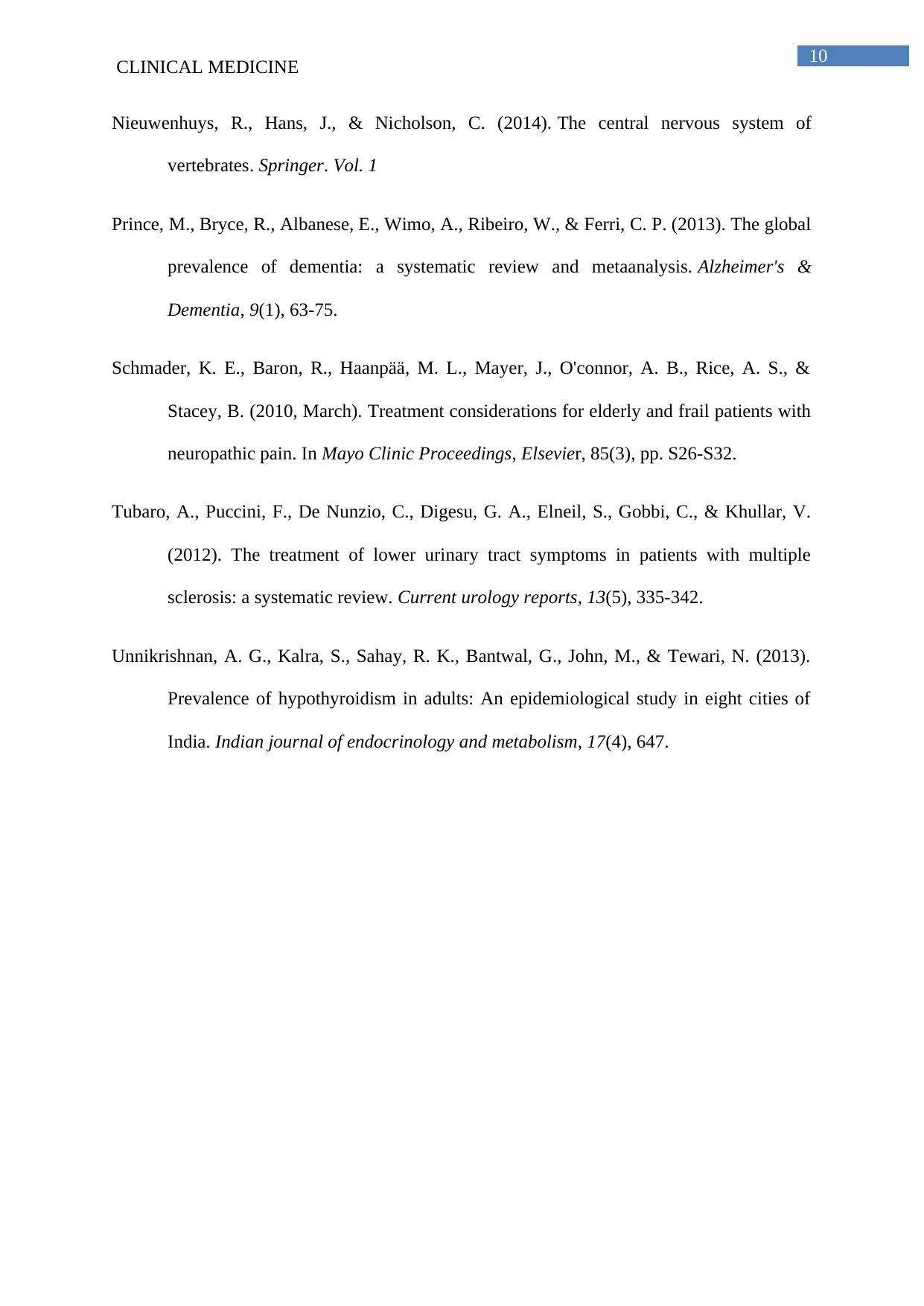
10
CLINICAL MEDICINE
Nieuwenhuys, R., Hans, J., & Nicholson, C. (2014). The central nervous system of
vertebrates. Springer. Vol. 1
Prince, M., Bryce, R., Albanese, E., Wimo, A., Ribeiro, W., & Ferri, C. P. (2013). The global
prevalence of dementia: a systematic review and metaanalysis. Alzheimer's &
Dementia, 9(1), 63-75.
Schmader, K. E., Baron, R., Haanpää, M. L., Mayer, J., O'connor, A. B., Rice, A. S., &
Stacey, B. (2010, March). Treatment considerations for elderly and frail patients with
neuropathic pain. In Mayo Clinic Proceedings, Elsevier, 85(3), pp. S26-S32.
Tubaro, A., Puccini, F., De Nunzio, C., Digesu, G. A., Elneil, S., Gobbi, C., & Khullar, V.
(2012). The treatment of lower urinary tract symptoms in patients with multiple
sclerosis: a systematic review. Current urology reports, 13(5), 335-342.
Unnikrishnan, A. G., Kalra, S., Sahay, R. K., Bantwal, G., John, M., & Tewari, N. (2013).
Prevalence of hypothyroidism in adults: An epidemiological study in eight cities of
India. Indian journal of endocrinology and metabolism, 17(4), 647.
CLINICAL MEDICINE
Nieuwenhuys, R., Hans, J., & Nicholson, C. (2014). The central nervous system of
vertebrates. Springer. Vol. 1
Prince, M., Bryce, R., Albanese, E., Wimo, A., Ribeiro, W., & Ferri, C. P. (2013). The global
prevalence of dementia: a systematic review and metaanalysis. Alzheimer's &
Dementia, 9(1), 63-75.
Schmader, K. E., Baron, R., Haanpää, M. L., Mayer, J., O'connor, A. B., Rice, A. S., &
Stacey, B. (2010, March). Treatment considerations for elderly and frail patients with
neuropathic pain. In Mayo Clinic Proceedings, Elsevier, 85(3), pp. S26-S32.
Tubaro, A., Puccini, F., De Nunzio, C., Digesu, G. A., Elneil, S., Gobbi, C., & Khullar, V.
(2012). The treatment of lower urinary tract symptoms in patients with multiple
sclerosis: a systematic review. Current urology reports, 13(5), 335-342.
Unnikrishnan, A. G., Kalra, S., Sahay, R. K., Bantwal, G., John, M., & Tewari, N. (2013).
Prevalence of hypothyroidism in adults: An epidemiological study in eight cities of
India. Indian journal of endocrinology and metabolism, 17(4), 647.
1 out of 11
Your All-in-One AI-Powered Toolkit for Academic Success.
+13062052269
info@desklib.com
Available 24*7 on WhatsApp / Email
![[object Object]](/_next/static/media/star-bottom.7253800d.svg)
Unlock your academic potential
© 2024 | Zucol Services PVT LTD | All rights reserved.

